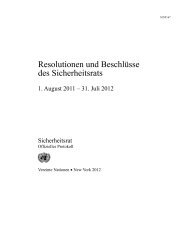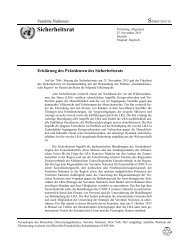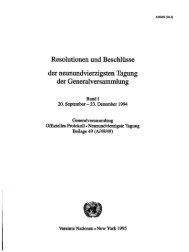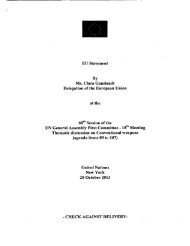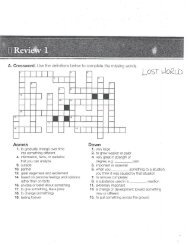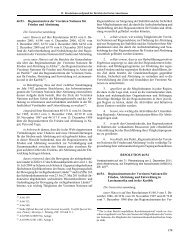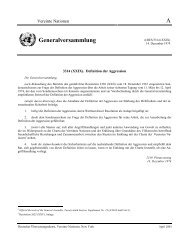IATG 01.80
IATG 01.80
IATG 01.80
Create successful ePaper yourself
Turn your PDF publications into a flip-book with our unique Google optimized e-Paper software.
MTNTe = (E d<br />
exp/E d<br />
TNT) . Mexp<br />
Table 19: TNT Equivalence<br />
8<br />
<strong>IATG</strong> <strong>01.80</strong>:2011[E]<br />
1st Edition (2011-10-01)<br />
MTNTe = TNT Equivalent Mass (kg)<br />
E d exp = Specific Detonation Energy of Explosive (J/kg)<br />
E d TNT) = Specific Detonation Energy of TNT (J/kg)<br />
Mexp = Mass of Explosive (kg)<br />
Table 20 contains pre-calculated TNT equivalence factors for a range of high explosives. These<br />
are accurate enough for design purposes.<br />
Explosive<br />
TNT Equivalent Mass<br />
Peak Pressure Impulse<br />
Pressure Range<br />
(MPa)<br />
Composition B 1.11 0.98 0.035 - 0.350<br />
Composition C3 1.08 1.01 0.035 - 0.350<br />
Composition C4 1.37 1.19 0.070 - 0.700<br />
Octol 75/25 1.06 1.06 -<br />
PETN 1.27 - 0.035 - 0.700<br />
RDX 1.14 1.09 -<br />
RDX / TNT 60/40 (Cyclotol) 1.14 1.09 0.035 - 0.350<br />
Tetryl 1.07 - 0.021 - 0.140<br />
TNT 1.00 1.00 Standard<br />
Tritonal 1.07 0.96 0.035 - 0.700<br />
8 Ballistics<br />
8.1 Gurney<br />
Table 20: TNT Equivalence<br />
The Gurney Equations 13 are a range of formulae used in explosives engineering to predict how fast<br />
an explosive will accelerate a surrounding layer of metal or other material when the explosive<br />
detonates. This determines how fast fragments are released on detonation of an item of<br />
ammunition. This initial fragment velocity can then be used with other ballistic equations to predict<br />
either danger areas or fragment penetration.<br />
Cylindrical Charge Equation 14<br />
(V/√2E) = ((M/Cexp) + ½)) -1/2<br />
Spherical Charge Equation 15<br />
(V/√2E) = ((M/Cexp) + 3/5)) -1/2<br />
Table 21: Gurney Equations 17<br />
V = Initial Fragment Velocity (m/s)<br />
√2E = Gurney Constant for a given explosive (m/s)<br />
M = Mass of Fragment (kg) 16<br />
Cexp = Explosive Charge Mass (kg)<br />
13<br />
Gurney, R. W. The Initial Velocities of Fragments from Bombs, Shells, and Grenades, BRL-405. Ballistic Research<br />
Laboratory, Aberdeen, Maryland. USA. 1943.<br />
14<br />
First order approximation for most high explosive artillery shells, mortar bombs and missile warheads.<br />
15<br />
Use for military grenades and some cluster bomblets.<br />
16<br />
For an artillery shell this is usually the base for which an estimate of mass is made from the total body mass.<br />
17<br />
There are other Gurney equations for symmetrical, asymmetrical, open faced and infinitely tamped sandwiches. These<br />
are beyond the scope of this <strong>IATG</strong> and have hence been excluded.



